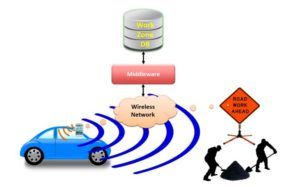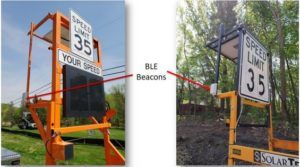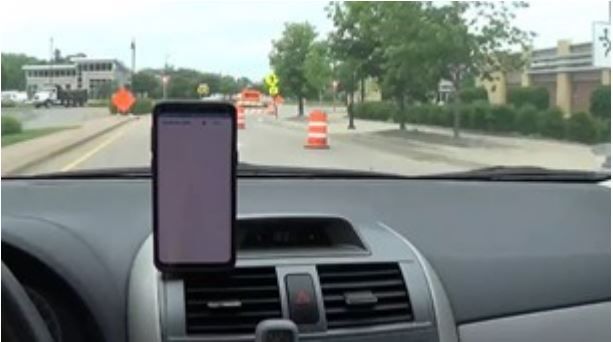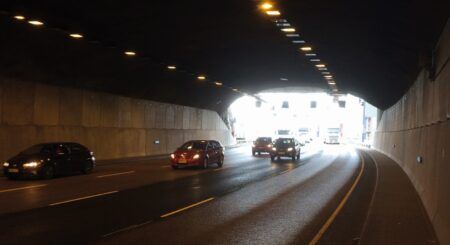In a project sponsored by the Roadway Safety Institute, University of Minnesota (UMN) researchers have developed a system that uses Bluetooth ‘tags’ to trigger in-vehicle audio warnings when approaching a highway workzone.
According to USDOT data, more than 20,000 highway personnel are injured or killed in workzones each year. For several years, UMN researchers have been teaming up on an interdisciplinary effort to develop a Bluetooth-based system that can be placed in workzones to deliver advance warning messages to drivers. In a new project that uses Bluetooth tags that can be easily attached to traffic signs and other objects in and around highway workzones, field tests have shown that the system is capable of providing dynamic, location-based in-vehicle messages for motorists approaching a construction area.
 The latest research takes the previously designed prototype system, which uses inexpensive Bluetooth Low Energy (BLE) tags placed in or ahead of workzones to deliver non-distracting audio alert messages through a smartphone or vehicle infotainment system, and tests it in real-world situations. The objective was to refine the previously developed in-vehicle message system to incorporate a sustainable power source design, implement results from earlier human factors studies to provide workzone information to motorists, and evaluate the system’s performance.
The latest research takes the previously designed prototype system, which uses inexpensive Bluetooth Low Energy (BLE) tags placed in or ahead of workzones to deliver non-distracting audio alert messages through a smartphone or vehicle infotainment system, and tests it in real-world situations. The objective was to refine the previously developed in-vehicle message system to incorporate a sustainable power source design, implement results from earlier human factors studies to provide workzone information to motorists, and evaluate the system’s performance.
To field test the workzone warning system, researchers deployed several BLE tags at three workzones in the Twin Cities metropolitan area. With the previously developed app, called WorkzoneAlert, running in the background on a smartphone, the research team drove a sedan and a minivan through each of the three workzones at different times of the day to evaluate the system’s performance under different traffic conditions. Bluetooth detection rate, range, and available reaction time were used as performance measures for system evaluation, and vehicle location and timing of each triggered message were logged for data analysis.
 Results of the field test show that the WorkzoneAlert app is able to reliably detect the Bluetooth tag placed an average of 417 feet (127m) away on traffic signs or portable radar speed signs. In addition, researchers found the system was able to successfully announce the corresponding message associated with each Bluetooth beacon. At a posted workzone speed limit of 35-45mph (56-72km/h), the system allowed five to nine seconds of reaction time prior to the motorists approaching the location where the beacons were installed. In the future, UMN researchers expect to use the results from this study to prepare for a field operational test to continue evaluating the system.
Results of the field test show that the WorkzoneAlert app is able to reliably detect the Bluetooth tag placed an average of 417 feet (127m) away on traffic signs or portable radar speed signs. In addition, researchers found the system was able to successfully announce the corresponding message associated with each Bluetooth beacon. At a posted workzone speed limit of 35-45mph (56-72km/h), the system allowed five to nine seconds of reaction time prior to the motorists approaching the location where the beacons were installed. In the future, UMN researchers expect to use the results from this study to prepare for a field operational test to continue evaluating the system.
“Providing drivers with tailored in-vehicle messages before they arrive at highway workzones has the potential to save lives and prevent many injuries,” explained Chen-Fu Liao, a senior research associate at the UMN’s Department of Mechanical Engineering. “In recent years, the challenges of workzone safety and mobility have been exacerbated by the growing issue of distracted driving. Our research uses in-vehicle spoken messages to calibrate drivers’ understanding of the workzone and reduce risky behaviour associated with distraction. We believe this approach could provide an alternative to automatic speed enforcement for changing driver behaviour in workzones by providing dynamic and timely workzone information such as awareness of workers on-site, changing traffic conditions, or hazards in the environment.”





